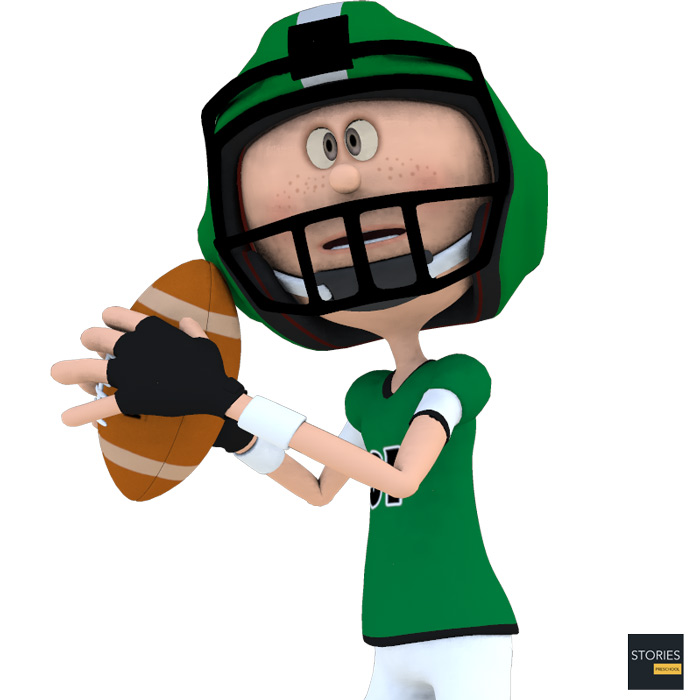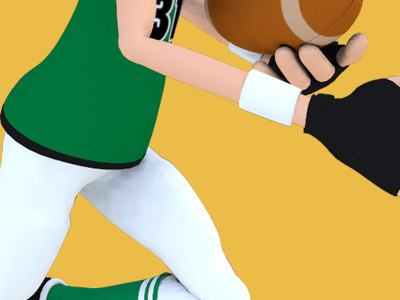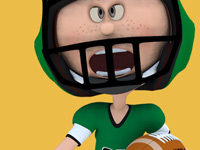American football

Quarterback (QB)
Quarterback (commonly abbreviated to QB) is a position in American and Canadian football. Quarterbacks are members of the offensive team and line up directly behind the offensive line. In modern American football, the quarterback is usually considered the leader of the offensive team, and is often responsible for calling the play in the huddle.
Leadership
In the NFL, while the starting quarterback has no other responsibility or authority, he may, depending on the league or individual team, have various informal duties, such as participation in pre-game ceremonies, the coin toss, or other events outside the game.
Often compared to captains of other team sports, before the implementation of NFL team captains in 2007, the starting quarterback was usually the de facto team leader and well-respected player on and off the field. Since 2007, when the NFL allowed teams to designate several captains to serve as on-field leaders, the starting quarterback has usually been one of the team captains as the leader of the team's offense.
After a Super Bowl victory, the starting quarterback is the first player (and third person after the team owner and head coach) to be presented with the Vince Lombardi Trophy. The starting quarterback of the victorious Super Bowl team is often chosen for the "I'm going to Disney World!" campaign (which includes a trip to Walt Disney World for them and their families), whether they are the Super Bowl MVP or not; examples include Joe Montana (XXIII), Trent Dilfer (XXXV), and Peyton Manning (50). Dilfer was chosen even though teammate Ray Lewis was the MVP of Super Bowl XXXV, due to the bad publicity from Lewis' murder trial the prior year.

Overview
In modern American football, the quarterback is usually the leader of the offense. The quarterback touches the ball on almost every offensive play, and his successes and failures can have a significant impact on the fortunes of his team. Accordingly, the quarterback is among the most glorified and scrutinized positions in team sports. Prior to each play, the quarterback will usually tell the rest of his team which play the team will run. After the team is lined up, the center will pass the ball back to the quarterback (a process called the snap). Usually on a running play, the quarterback will then hand or pitch the ball backwards to a half back or full back. On a passing play, the quarterback is almost always the player responsible for trying to throw the ball downfield to an eligible receiver downfield. Additionally, the quarterback will often run with the ball himself, which could be part of a designed play like the option run or quarterback sneak, or it could be an impromptu effort to avoid being sacked by the defense.
Depending on the offensive scheme by his team, the quarterback's role can vary. In systems like the triple option the quarterback will only pass the ball a few times per a game, if at all, while the pass-heavy spread offense as run by schools like Texas Tech requires quarterbacks to throw the ball in most plays. The passing game is emphasized heavily in the Canadian Football League (CFL), where there are only three downs as opposed to the four downs used in American football, a larger field of play and an extra eligible receiver. Different skillsets are required of the quarterback in each system - quarterbacks that perform well in a pass-heavy spread offensive system, a popular offensive scheme in the NCAA and NFHS, rarely perform well in the National Football League (NFL), as the fundamentals of the pro-style offense used in the NFL are very different from those in the spread system. while quarterbacks in Canadian football need to be able to throw the ball often and accurately. In general, quarterbacks need to have physical skills such as arm strength, mobility, and quick throwing motion, in addition to intangibles such as competitiveness, leadership, intelligence, and downfield vision.
In the NFL, quarterbacks are required to wear a uniform number between 1 and 19. In the National Collegiate Athletic Association (NCAA) and National Federation of State High School Associations (NFHS), quarterbacks are required to wear a uniform number between 1 and 49; in the NFHS, the quarterback can also wear a number between 80 and 89. In the CFL, the quarterback can wear any number from 0 to 49 and 70 to 99. Because of their numbering, quarterbacks are eligible receivers in the NCAA, NFHS, and CFL; in the NFL, quarterbacks are eligible receivers if they are not lined up directly under center.
Trends and other roles
In addition to their main role, quarterbacks are occasionally used in other roles. Most teams utilize a backup quarterback as their holder on placekicks. A benefit of using quarterbacks as holders is that it would be easier to pull off a fake field goal attempt, but many coaches prefer to use punters as holders because a punter will have far more time in practice sessions to work with the kicker than any quarterback would. In the Wildcat, a formation where a halfback lines up behind the center and the quarterback lines up out wide, the quarterback can be used as a receiving target or a blocker. A more rare use for a quarterback is to punt the ball himself, a play known as a quick kick. Denver Broncos quarterback John Elway was known to perform quick kicks occasionally, typically when the Broncos were facing a third-and-long situation. Philadelphia Eagles quarterback Randall Cunningham, an All-America punter in college, was also known to punt the ball occasionally, and was assigned as the team's default punter for certain situations, such as when the team was backed up inside their own five-yard line.
As Roger Staubach's back-up, Dallas Cowboys quarterback Danny White was also the team's punter, opening strategic possibilities for coach Tom Landry. Ascending the starting role upon Staubach's retirement, White held his position as the team's punter for several seasons—a double duty he performed to All-American standard at Arizona State University. White also had two touchdown receptions as a Dallas Cowboy, both from the halfback option.
Special tactics
If quarterbacks are uncomfortable with the formation the defense is using, they may call an audible change to their play. For example, if a quarterback receives the call to execute a running play, but he notices that the defense is ready to blitz—that is, to send additional defensive backs across the line of scrimmage in an attempt to tackle the quarterback or hurt his ability to pass—the quarterback may want to change the play. To do this, the quarterback yells a special code, like "Blue 42," or "Texas 29," which tells the offense to switch to a specific play or formation, but it all depends on the quarterbacks' judgment of the defenses' alignment.
Also, quarterbacks can "spike" or throw the football at the ground to stop the official game clock. For example, if a team is down by a field goal with only seconds remaining, a quarterback may spike the ball to prevent the game clock from running out. This usually allows the field goal unit to come onto the field, or attempt a final "Hail Mary pass". However, if a team is winning, a quarterback can keep the clock running by kneeling after the snap. This is normally done when the opposing team has no timeouts and there is little time left in the game, as it allows a team to burn up the remaining time on the clock without risking a turnover or injury.
Dual-threat quarterbacks
A dual-threat quarterback possesses the skills and physique to run with the ball if necessary. With the rise of several blitz-heavy defensive schemes and increasingly faster defensive players, the importance of a mobile quarterback has been redefined. While arm power, accuracy, and pocket presence – the ability to successfully operate from within the "pocket" formed by his blockers – are still the most important quarterback virtues, the ability to elude or run past defenders creates an additional threat that allows greater flexibility in a team's passing and running game.
Dual-threat quarterbacks have historically been more prolific at the college level. Typically, a quarterback with exceptional quickness is used in an option offense, which allows the quarterback to hand the ball off, run it himself, or pitch it to the running back following him at a distance of three yards outside and one yard behind. This type of offense forces defenders to commit to the running back up the middle, the quarterback around the end, or the running back trailing the quarterback. It is then that the quarterback has the "option" to identify which match-up is most favorable to the offense as the play unfolds and exploit that defensive weakness. In the college game, many schools employ several plays that are designed for the quarterback to run with the ball. This is much less common in professional football, except for a quarterback sneak, but there is still an emphasis on being mobile enough to escape a heavy pass rush. Historically, high-profile dual-threat quarterbacks in the NFL were uncommon, Steve Young and John Elway being among the notable exceptions, leading their teams to three and 5 Super Bowl appearances respectively, and Michael Vick, whose rushing ability was a rarity in the early 2000s, although he never led his team to a Super Bowl. In recent years, quarterbacks with dual-threat capabilities have become more popular. Recently the number of dual-threat quarterbacks has increased. Examples of dual-threat quarterbacks playing in the NFL include Andrew Luck, Cam Newton, Ryan Tannehill, Colin Kaepernick, Blake Bortles, Tyrod Taylor, Alex Smith, Russell Wilson, and Marcus Mariota.
Two-quarterback system
Some teams employ a strategy which involves the use of more than one quarterback during the course of a game. This is more common at lower levels of football, such as high school or small college, but rare in major college or professional football.
There are four circumstances in which a two-quarterback system may be used.
The first is when a team is in the process of determining which quarterback will eventually be the starter, and may choose to use each quarterback for part of the game in order to compare the performances. For instance, the Seattle Seahawks' Pete Carroll used the pre-season games in 2012 to select Russell Wilson as the starting quarterback over Matt Flynn and Tarvaris Jackson.
The second is a starter–reliever system, in which the starting quarterback splits the regular season playing time with the backup quarterback, although the former will start playoff games. This strategy is rare, and was last seen in the NFL in the "WoodStrock" combination of Don Strock and David Woodley, which took the Miami Dolphins to the Epic in Miami in 1982 and Super Bowl XVII the following year. The starter-reliever system is distinct from a one-off situation in which a starter is benched in favor of the back-up because the switch is part of the game plan (usually if the starter is playing poorly for that game), and the expectation is that the two players will assume the same roles game after game.
The third is if a coach decides that the team has two quarterbacks who are equally effective and proceeds to rotate the quarterbacks at predetermined intervals, such as after each quarter or after each series. Southern California high school football team Corona Centennial operated this model during the 2014 football season, rotating quarterbacks after every series. In a game against the Chicago Bears in the seventh week of the 1971 season, Dallas Cowboys head coach Tom Landry alternated Roger Staubach and Craig Morton on each play, sending in the quarterbacks with the play call from the sideline.
The fourth, still occasionally seen in major-college football, is the use of different quarterbacks in different game or down/distance situations. Generally this involves a running quarterback and a passing quarterback in an option or wishbone offense. In Canadian football, quarterback sneaks or other runs in short-yardage situations tend to be successful as a result of the distance between the offensive and defensive lines being one yard. Drew Tate, a quarterback for the Calgary Stampeders, was primarily used in short-yardage situations and led the CFL in rushing touchdowns during the 2014 season with ten scores as the backup to Bo Levi Mitchell. This strategy had all but disappeared from professional American football, but returned to some extent with the advent of the "wildcat" offense. There is a great debate within football circles as to the effectiveness of the so-called "two-quarterback system". Many coaches and media personnel remain skeptical of the model. Teams such as USC (Southern California), OSU (Oklahoma State), Northwestern, and smaller West Georgia have utilized the two-quarterback system; West Georgia, for example, uses the system due to the skill sets of its quarterbacks. Teams like these use this situation because of the advantages it gives them against defenses of the other team, so that the defense is unable to adjust to their game plan.
SPORTS



American Football
Game play in American football consists of a series of downs, individual plays of short duration, outside of which the ball is dead or not in play. These can be plays from scrimmage – passes, runs, punts, or field goal attempts (from either a place kick or a drop kick) – or free kicks such as kickoffs and fair catch kicks. Substitutions can be made between downs, which allows for a great deal of specialization as coaches choose the players best suited for each particular situation. During a play, each team should have no more than 11 players on the field, and each of them has specific tasks assigned for that specific play.
Rules and gameplay
- Scoring
- Maneuvers
- Strategy
- Play types
- Penalties
- Turnovers
- Downs
- Teams and positions
- Field
- Equipment
- Duration and time stoppages
- Advancing the ball and downs
- Kicking
- Officials and fouls
Positions
Offensive (Interior) line
Backs and receivers
Defensive line
Linebackers
Defensive backs
Special teams
- Kicker (K)
- Holder (H)
- Long snapper (LS)
- Punter (P)
- Kickoff specialist (KOS)
- Kick returner (KR) and Punt returner (PR)
- Upback
- Gunner
- Jammer


RESOURCES
This article uses material from the Wikipedia articles "American football", "American football positions" and "Quarterback", which is released under the Creative Commons Attribution-Share-Alike License 3.0.
© Stories Preschool. All Rights Reserved.





